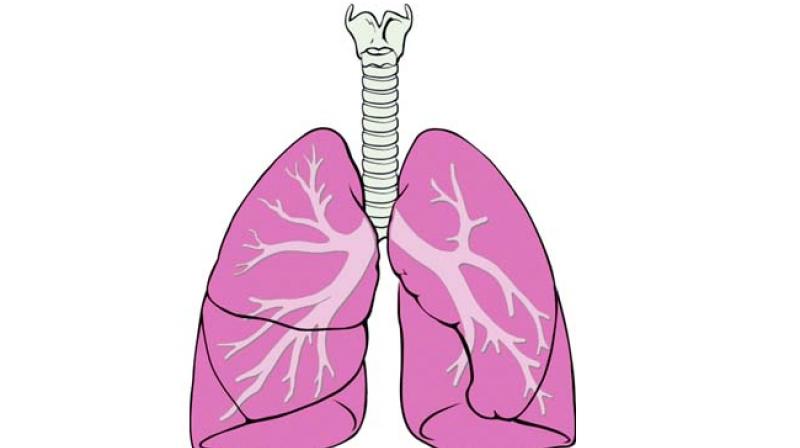A tricky lung disease
Lung ailments may interfere in your daily life keeping you from living your best moments to the fullest.

Respiratory infections and diseases are usually at their peak in winter but even so, owing to rising pollution levels and lifestyle challenges, there has been a significant rise in lung diseases. Of these, five to 10 per cent are interstitial lung diseases which continue to pose a challenge when it comes to diagnosis and awareness among people.
Interstitial lung disease or ILD is a broad category of lung diseases that includes more than 130 disorders characterised by fibrosis or inflammation of the lungs. This condition arises when the lungs become inflamed or scarred, which disrupts the organ tissue and leads to decreased ability to extract oxygen from the air.
The progression of ILD varies from disease to disease and from person to person. Each individual responds differently to treatment, so it is important for a doctor to monitor every patient, explains Dr Vijay Kumar Chennamchetty, consultant pulmonologist, Apollo Hospitals.
Q. What are the common symptoms of ILD?
The most common symptoms of ILD are shortness of breath with exercise and a non-productive cough. These symptoms are generally slowly progressive, although rapid worsening can also occur. Some people may also have a variety of other symptoms including fever, weight loss, fatigue and muscle and joint pains.
Q. What are the causes of ILD?
Some of the known causes of ILD include autoimmune diseases such as scleroderma, vasculitis, systemic lupus erythematosus, rheumatoid arthritis and polymyositis/dermatomyositis. Many kinds of occupational and environmental exposures such as inorganic dust (silica, hard metal dusts), organic dust (bacteria, animal proteins), gases, fumes, drugs and poisons, infections, residue of active infection of any type and ongoing chronic infections are also known to cause ILD.
Q. How is interstitial lung disease diagnosed?
When the diagnosis of ILD is suspected, your doctor considers the following:
Your medical history: This includes a review of all of the symptoms, a listing of current and former medications and a review of any environmental and occupational exposures to dust, gases, chemicals, pets (in particular birds) and humidifiers.
A complete physical examination: Findings of crackling sounds in the lungs and changes in the skin, joints and fingernails can help direct further evaluation.
Chest X-ray and high-resolution computed tomography (CT) scan: Sometimes a CT scan pattern will conclude a specific diagnosis and thus we can avoid a lung biopsy.
Pulmonary function tests: Help in diagnosing severity of functional limitation and when done serially, will help us in detecting rapidity of worsening.
Arterial blood gas: This test measures the amount of oxygen and carbon dioxide in your blood.
Exercise testing: This test may show a decrease in your oxygen level during activity. Testing may include a six-minute walk, oxygen titration and exercise tolerance test.
Laboratory data: Blood work may be done to test for autoimmune disease and other disorders that can cause ILD.
Bronchoscopy with bronchoalveolar lavage: A bronchoscopy may be done to check for inflammatory cells in lungs or to sample small pieces of the lung to look for evidence of a specific ILD.
Surgical lung biopsy: In many cases of ILD, a surgical lung biopsy is needed to get enough lung tissue to make a specific diagnosis.
Q. What are the treatment options for ILD?
Treatment for ILD is based upon the diagnosis and may differ depending on the result of the tests. Many forms of ILD can be treated successfully with medications. ILD that is primarily the result of inflammation in the lung can often be treated with immunosuppressive medications. However, our current available therapies are not thought to reverse scarring or fibrosis that has already taken place. In some cases, where medication is not felt to be useful, a lung transplant is recommended. If an occupational or environmental exposure has been identified, removal from the source of the problem is essential.
Q. Are there any therapies that people can opt for apart from medicines?
Yes, there are several options available when it comes to therapies.
Oxygen Therapy: Oxygen is required for some people with ILD because of the low level of oxygen in their blood. Some may need oxygen therapy all the time while others may need it only while sleeping and exercising. Improving the level of oxygen in the blood through the use of supplemental oxygen can help relieve the strain on the heart and lungs and improve the symptoms of shortness of breath and fatigue. Most people feel that once they are on oxygen, they are more active as they are not as short of breath as they used to be.
Pulmonary Rehabilitation: This programme includes education, exercise conditioning, breathing and energy-saving techniques, respiratory therapy evaluation, nutritional counselling and psychosocial support. The specific goals of pulmonary rehabilitation are to improve the quality of life by decreasing respiratory symptoms and complications and improving exercise performance.
Lung Transplant: If any other therapies fail, lung transplant is an option for some advanced cases. With improved surgical techniques and post-transplant care, this may offer an improved quality of life.

